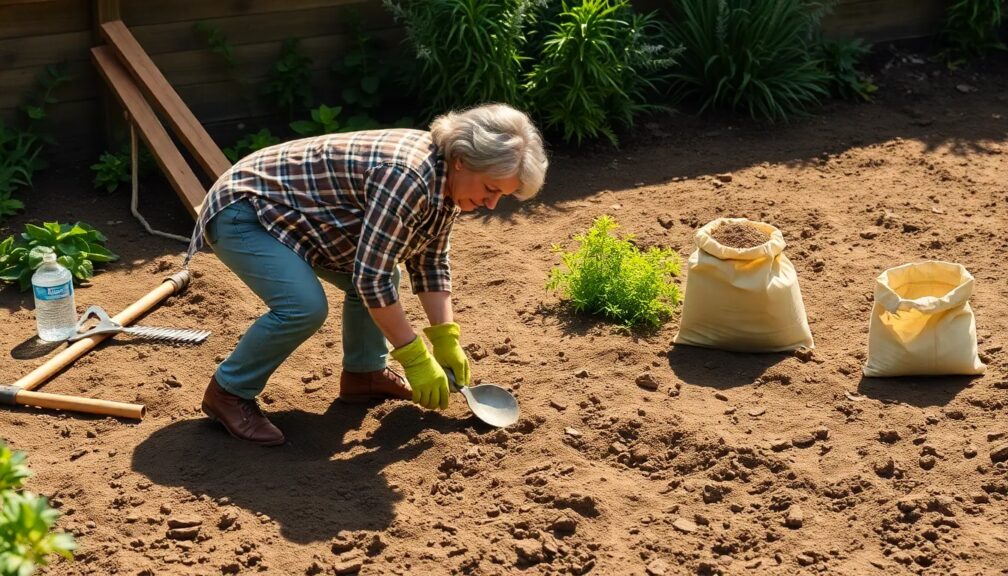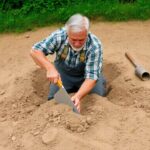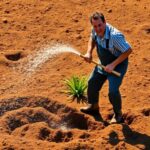How do you loosen hard soil without a tiller

Welcome to Our Guide on How to Loosen Hard Soil Without a Tiller
Dealing with hard, compacted soil can be a daunting task for any gardener or landscaper. Whether you're preparing a new garden bed or looking to improve the condition of an existing plot, the challenge of aerating and loosening soil without the use of a tiller is one that many face. Tilling can be time-consuming and requires access to expensive equipment. Fortunately, there are alternative methods that can effectively break up tough soil, improve drainage, and encourage healthy plant growth. In this article, we will explore a variety of techniques, including organic amendments, manual aerating methods, and the use of dynamic plants to naturally condition soil. Get ready to transform your hard-packed dirt into a fertile haven for your plants.
How to loosen compacted soil without tilling
Imagine transforming your garden from a hard-packed wasteland to a flourishing oasis, all without the back-breaking labor of tilling. Sounds too good to be true? Well, it's not only possible, but learning this method can also improve your soil's health and contribute to a more sustainable gardening practice.
Start by introducing organic matter such as compost or leaf mold. This isn't just a one-time fix; it's the beginning of a virtuous cycle that continues to condition your soil over time. The secret lies in the earth's own workforce: worms and microbes. By adding organic matter, you're inviting these natural tillers to move in, munch on your offerings, and naturally aerate the soil.
But that's just the tip of the iceberg. Here's a sneak peek at what else you can do:
- Employ cover crops – These are not just placeholders for your next batch of plants; they're powerful allies that can break up soil with their roots and add nutrients when they decompose.
- Utilize aeration tools – Imagine penetrating compacted soil with minimal effort, allowing air, water, and nutrients to reach the roots of your plants.
- Embrace mulching – It's like giving your soil a protective blanket that also feeds it as it breaks down. Say goodbye to crusty soil surfaces and hello to moist, crumbly soil that plants love.
The journey to revitalized soil doesn't end here. This is just the beginning of a deeper dive into a world where soil management becomes less of a chore and more of an enjoyable part of your gardening routine. Intrigued? There's plenty more to discover about the techniques that will not only save you time but also contribute to a healthier, more vibrant garden. Stay tuned, because you won't want to miss what's coming next in the quest for the perfect soil.
How to loosen compacted soil in pots
Are you ready to transform your potted plants from struggling survivors to thriving green beauties? The secret lies beneath the surface in the dark, unseen world of soil health. Ignoring the signs of compaction can lead to a host of plant problems that you simply can't afford to overlook.
Imagine your roots gasping for air, unable to stretch out and absorb the vital nutrients they desperately need. Compaction turns the soil into an impenetrable fortress that stunts growth, but fear not, because the solution is at your fingertips.
Unlock the full potential of your potted plants with these simple yet effective steps:
1. Start with a Soil Assessment
- Gently probe the soil with your fingers. Does it feel hard and unyielding?
- Observe water drainage. Does water sit on top of the soil for ages?
2. Aerate
- Use a fork or a special soil aerator to gently pierce the soil, allowing air to penetrate.
- This isn't a one-time fix; make aeration a regular part of your plant care routine.
3. Amend the Soil
- Introduce organic matter like compost or worm castings to improve texture and nutrient content.
- Perk up the potting mix with perlite or vermiculite for enhanced aeration.
4. Water Wisely
- Overwatering can exacerbate compaction. Learn the specific needs of your plants.
- Consider self-regulating watering systems to maintain the perfect moisture balance.
5. Repot with Care
- Sometimes, starting fresh is the best option. Choose a larger pot to give roots room to roam.
- Mix in new, fluffy soil and handle roots with the utmost care to reduce stress.
Don't let compacted soil be the silent killer of your potted paradise. By addressing this critical issue, you'll not only witness a remarkable revival of plant health but also become the envy of plant enthusiasts everywhere. Stay tuned as we reveal even more insider tips and tricks to ensure your indoor oasis flourishes like never before!
How to fix compacted soil in lawn
Are you struggling with your lawn's health, noticing that it's not as lush and vibrant as it could be? The culprit might be right beneath your feet: compacted soil. This stealthy adversary suffocates grass roots and hinders water absorption, leading to a lackluster lawn that could be the neighborhood's eyesore. But fear not! Transforming your hard-packed turf into a thriving oasis is within reach, and we're here to guide you through the process.
First, let's unearth the secrets of aeration. Imagine giving your lawn a breath of fresh air, literally. Aeration involves perforating the soil with small holes to allow air, water, and nutrients to penetrate built-up grass or lawn thatch. This can be achieved with tools as simple as a garden fork for small patches, or with a mechanical aerator for larger areas. The result? Roots that dive deeper, creating a more resilient and vibrant lawn.
But we're not stopping at just poking holes. The addition of organic matter is like a health elixir for your soil. Spreading compost or top dressing across your lawn not only improves soil structure but also encourages beneficial microbial activity. This organic booster works its magic slowly, promising gradual but lasting improvements to your lawn's health.
And let's not overlook the power of proper maintenance. Regular mowing, watering, and fertilizing play pivotal roles in preventing soil compaction in the first place. A well-maintained lawn is not just a pride-inducing sight; it's also more equipped to withstand the pressures of foot traffic and environmental stresses.
Ready to learn more and transform your compacted battleground into a plush, green sanctuary? The journey to a healthier lawn is both rewarding and attainable, and we've only scratched the surface. Stay tuned to uncover the full arsenal of strategies that can revive your lawn, ensuring it's not only the envy of your neighborhood but also a testament to your green thumb prowess.
How to fix compacted soil in garden
Imagine stepping into your garden, expecting to see a lush landscape, but instead, you're met with stunted growth and lackluster plants. The culprit? Compacted soil. It's a common issue, but one that can have a dramatic impact on the health of your garden. But fear not, the solution is within reach, and the transformation can be astounding.
First, let’s uncover the signs that you're dealing with compacted soil. Are you noticing water pooling on the surface after a rainstorm? Or perhaps your plants are struggling to take root? These are telltale indicators that your garden is crying out for help. Now, brace yourself as we delve into the secrets of reviving your garden's vitality.
Step 1: Assessment – Before you take action, you need to understand the extent of the soil compaction. A simple way to test this is by taking a screwdriver and trying to push it into the soil. If it's a struggle, compaction is likely your issue.
Step 2: Aeration – This is a game-changer for your garden. Aeration involves creating holes in the soil to improve oxygen circulation, water infiltration, and nutrient uptake. Tools like a garden fork or core aerator can be your allies in this mission.
Step 3: Add Organic Matter – Organic matter is like the secret sauce for soil health. By adding compost or well-rotted manure, you can significantly improve soil structure and fertility. This isn't just a quick fix; it's a long-term investment in your garden's future.
Step 4: Grow Cover Crops – Did you know that certain plants can actually mend your soil? Cover crops, such as clover or winter rye, can break up compacted soil with their roots and add organic matter when tilled back into the soil. It's a natural and effective strategy to ensure your garden thrives.
Step 5: Mulch Magic – Mulch isn't just for curb appeal. It helps maintain moisture, regulate temperature, and over time, breaks down to further enrich the soil. Applying a layer of mulch can be the protective blanket your garden didn't know it needed.
But wait, there's more! To truly conquer compacted soil, you need to adopt practices that prevent it from happening again. Avoid overworking wet soil, reduce foot traffic in garden beds, and consider using raised beds to provide your plants with the perfect growing conditions.
The journey to transform your compacted soil into a vibrant, thriving ecosystem is not only possible, it's within your grasp. With these steps, you'll not only fix your soil, you'll set the stage for a garden that captivates and flourishes. Can you afford to miss the opportunity to unleash your garden's full potential? Stay tuned, as we'll reveal even more insights to take your gardening endeavors to the next level.
Does turning over soil kill weeds
Garden enthusiasts and green thumbs, have you ever wondered about the battle beneath our boots? The age-old practice of turning over soil may seem like a simple act, but its impact on the relentless enemy known as weeds is a topic of hot debate and keen interest. Imagine uncovering the hidden truths of this gardening technique and how it could transform your outdoor sanctuary.
The initial turnover of soil, often performed with a shovel or tiller, is a double-edged sword. It's true, the process can disrupt the life cycle of weeds, burying them deep beneath the earth, snatching them away from the life-giving sun. But what if I told you that this same action might also awaken dormant weed seeds, previously lying in wait, unleashing a fresh army of invaders?
As gardeners, we are always searching for methods to maintain our lush landscapes and bountiful vegetable plots. So, consider this: strategic soil turnover could be your ally or your adversary. The timing, depth, and frequency of this practice are critical factors that can tip the scales in your favor.
Unearth the secrets of optimal soil turnover techniques that could potentially save you countless hours of backbreaking weeding. From understanding the concept of a weed seed bank to the art of minimizing soil disturbance, the knowledge that awaits could be the key to a vibrant, virtually weed-free garden.
Stay with us as we delve deeper into these methods, revealing expert tips that have been honed over generations. Discover how to wield the power of soil turnover to your advantage, enhancing soil fertility and structure while keeping those pesky weeds at bay. Your dream garden is within reach, and the path to it is more intriguing than you might think. Prepare to transform your approach to gardening and witness the flourishing results. Are you ready to turn the soil on weeds for good? Keep reading, and your garden will thank you.
Consejo final: For someone interested in loosening hard soil without a tiller, patience and consistent effort are key. Employ the method of layering organic material, such as compost and mulch, to naturally break down the soil structure. Over time, this will enrich the soil and make it easier to work with. Remember to keep the soil moist to facilitate this process. May your garden thrive with your dedicated care. Take care as you cultivate your green space!
 How do you loosen soil without hurting roots
How do you loosen soil without hurting roots What softens hard soil
What softens hard soil How do you loosen heavily compacted soil
How do you loosen heavily compacted soil What tool is used to break up tough soil without getting stuck
What tool is used to break up tough soil without getting stuck How do you soften hard ground for digging
How do you soften hard ground for diggingIf you want to know more about similar articles like How do you loosen hard soil without a tiller you can visit category Gardening Tools.
Deja una respuesta